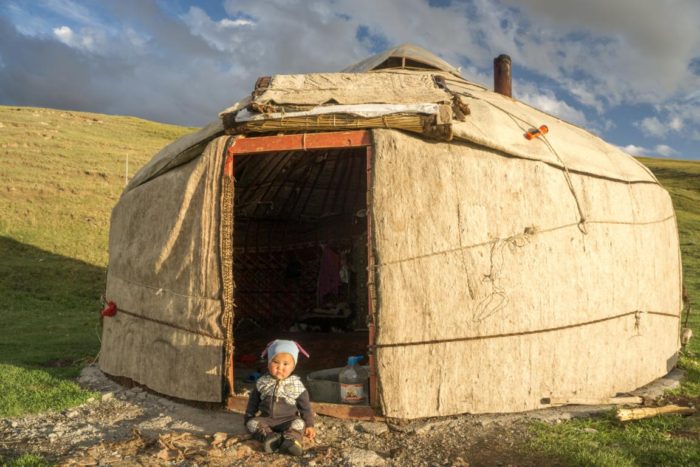The Catholic Church in Kyrgyzstan

Where is Kyrgyzstan?
Kyrgyzstan is a small nation in Central Asia. It received its independence from the Soviet Un-ion in 1991. The population is approximately 6 million with a mix of Kyrgyz, Uzbek, Russian, Uygur, Dungan, Ukrainian, Kurd, Tajik and Turks. Of these, 34% are younger than 15 years old. Most Kyrgyz live in rural areas, with only one third of the population residing in cities. Be-tween 87 and 90% of the population consider themselves to be Muslims. Is-lam dominates the religious and social landscape. Christians make up between 8-11% of the population. Catholics comprise a very small minority in this predominantly Muslim country. Until recently, the majority of Muslims have been rather moderate; however, there is an increasing trend towards the radicalization of certain elements within the population, most especially among young adults.

Who are the Catholics in Kyrgyzstan?
The Catholic Church, present in the country for at least 150 years, has traditionally been comprised of citizens with German, Polish, or Ukrainian heritage. The Apostolic Administration of Kyrgyzstan is one of smallest Catholic Church entities in the world and probably one of the most marginalized. Most of the Catholics here have Polish, German, Ukrainian or Korean roots; however, more and more people of other ethnic backgrounds are attending Holy Mass, includ-ing Russians, Kyrgyz and Uzbek.
The vast majority of these Catholics have emigrated to Europe or Russia over the past three decades.There are now some newer Catholics from different national groups, including Russians, Kyrgyz and Uzbek. There are currently estimated to be between 550-1500 Catholics in the country. There are three parish churches and many smaller Catholic communities spread throughout this country. There are currently seven priests and five Franciscan Sisters serving here.
 Catholic community in Bishkek in early 70thy.
Catholic community in Bishkek in early 70thy.
The first Catholic parish in Kyrgyzstan was established in 1956 but was soon destroyed by the communist regime. In 1968, the current parish and local Church started more assertive activity in Bishkek. This church continues to op-erate. In 2006 Pope Benedict XVI established the Apostolic Administration of Kyrgyzstan. In August 2017, after the unexpected death of Bishop Nikolaus Messmer, Fr. Anthony Corcoran SJ was appointed by the Holy See to serve as Apostolic Administrator of Kyrgyzstan.

Cathedral of St. Michael in Bishkek during ingress Mass (17.12.2017)of new Apostolic Administrator Fr. Anthony Corcoran SJ
Why does the Catholic Church feel rooted here?
- -The Catholic Church has a history in the country;
- -Papal Mission to the Society of Jesus (historical roots);
- -Provides us with the opportunity to offer remarkably vast pastoral, spiritual, and educa-tional resources in endeavoring to be faithful to the goal of the Church’s existence – the salvation and good (“flourishing”) of souls through living and sharing the light of our Faith in Je-sus Christ – in the challeng-ing context of this area.

Catholic volunteers organize activity for Muslim orphans and children from
poor families
How do we undertake this work?
- Pastoral Service of the tiny Catholic communities and continued search for ways of finding, (re)-evangelizing;
- catechizing and serving Christians;
- “Pre-evangelization” ministry with others (secularized, atheistic or passive);
- Pre-evangelization through en-countering students in educational/formational settings;
- Pre-evangelization through witness in humanitarian assistance;
- Witness to Christian mercy and charity;
- The ministry of consolation, including these and other ministries among people of our own faith and with some from other faiths.

Fr. Remigiusz Kalski SJ serving Holy Mass during catholic youth camp
Apostolic Overview with proposed projects
There are currently six Jesuit priests, one brother, one diocesan priest and six religious sisters from the Slovakian Congregation of School Sisters of St. Francis serving in Kyrgyzstan. There are three regular parishes in the territory of the Administration and more than ten smaller communities regularly visited by priests. The Church undertakes several social projects (Rehabilitation centers for alcoholics, support for orphanages, etc.) including the “Children Rehabilita-tion and Spirituality Center” on the shore of the enormous Issyk-Kul Lake.
 Issyk-kul lake, where our Spirituality Center is located, long 111 mi, is one of the biggest mountains lake in the world
Issyk-kul lake, where our Spirituality Center is located, long 111 mi, is one of the biggest mountains lake in the world
Kyrgyzstan is still primarily a secular country; however, as mentioned above, we observe a growing influence of radical Islam among a por-tion of the population. We consider the current period of time as a Kairos and endeavor to seize the opportunity provided by the fact that, for now, local authorities extend permission to construct new churches. We do not know what the future holds.
